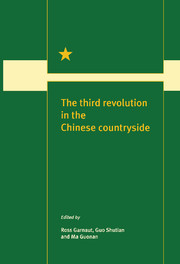Book contents
- Frontmatter
- Contents
- Figures
- Maps
- Tables
- Contributors
- Preface
- 1 The third revolution
- Feeding the people
- Marketing and price reform
- 6 Price reform for agricultural products
- 7 Grain marketing: from plan to market
- 8 Fertiliser price
- 9 Agricultural wholesale markets
- 10 The ‘wool war’ and the ‘cotton chaos’: fibre marketing
- 11 Conflict over cabbages: the reform of wholesale marketing
- Internationalisation
- Regional issues
- Institutional change
- References
- Index
7 - Grain marketing: from plan to market
from Marketing and price reform
Published online by Cambridge University Press: 04 August 2010
- Frontmatter
- Contents
- Figures
- Maps
- Tables
- Contributors
- Preface
- 1 The third revolution
- Feeding the people
- Marketing and price reform
- 6 Price reform for agricultural products
- 7 Grain marketing: from plan to market
- 8 Fertiliser price
- 9 Agricultural wholesale markets
- 10 The ‘wool war’ and the ‘cotton chaos’: fibre marketing
- 11 Conflict over cabbages: the reform of wholesale marketing
- Internationalisation
- Regional issues
- Institutional change
- References
- Index
Summary
The grain marketing system in the People's Republic of China has gone through four distinct periods
the free market system of the early 1950s
the state marketing system established in 1953
the dual system of market and plan which replaced the monopoly system in 1985–90
the post-1990 period created by the liberalisation of procurement and urban retail prices and grain marketing generally that is currently spreading across China.
This chapter describes and analyses reform of the grain marketing system in the fourth period.
Reform of China's grain marketing system is still incomplete, though the immediate targets of the fourth stage have largely been achieved. The goals and measures associated with the current reform process are quite clear. Review of progress so far promotes understanding of the directions in which the system will evolve in the future.
Background of the reform
In 1979 the government made a number of adjustments to grain marketing and price systems. One of these led to increases in state procurement prices. Another saw state mandatory procurement quotas gradually lowered, and prices for additional procurements increased by 50 per cent. These measures substantially improved incentives to increase production.
Urban retail prices were kept at the level established in 1965, resulting in a gap between producer and urban consumer prices. This gap was subsidised from the government budget. With rapid increases in grain production and state sales, the cost of this subsidy rose sharply, accounting for 13.5 per cent of state expenditure in 1984.
- Type
- Chapter
- Information
- The Third Revolution in the Chinese Countryside , pp. 89 - 99Publisher: Cambridge University PressPrint publication year: 1996



